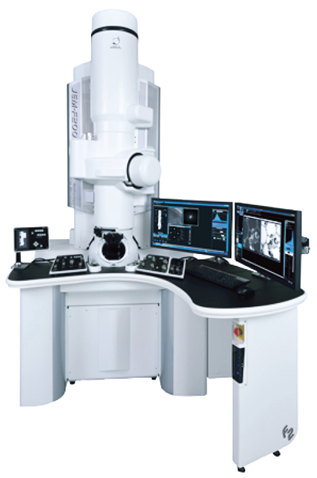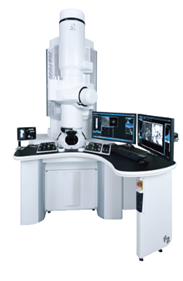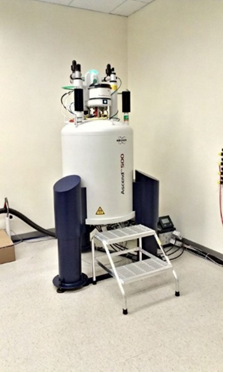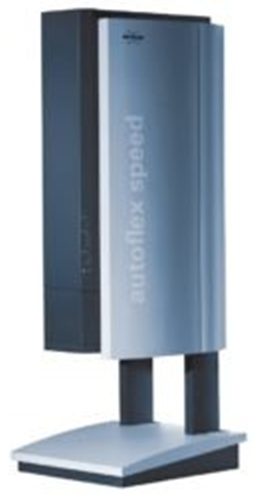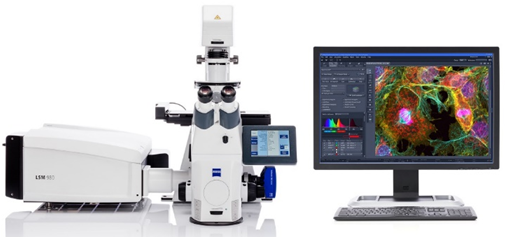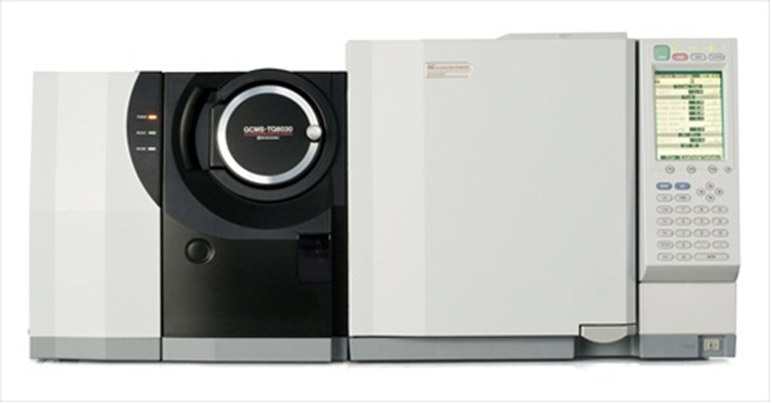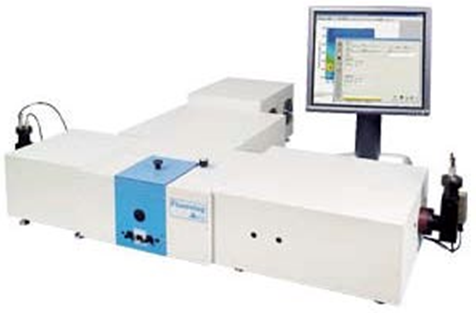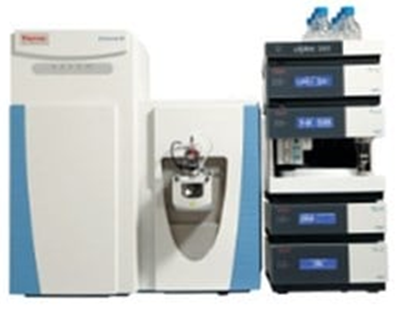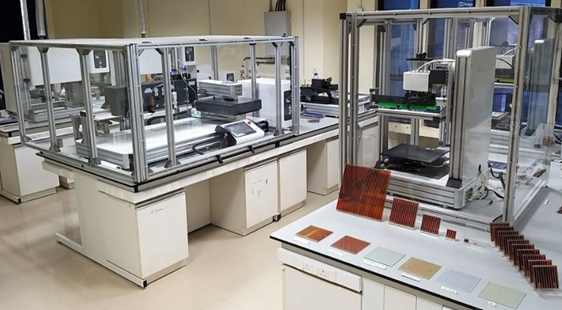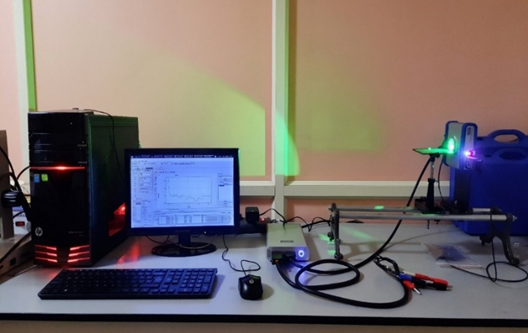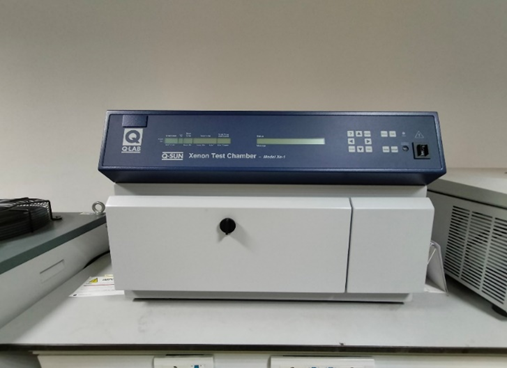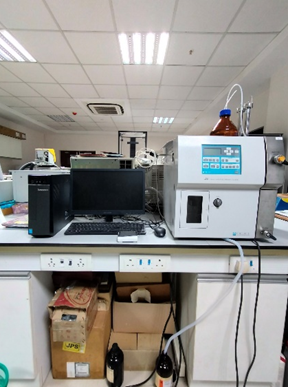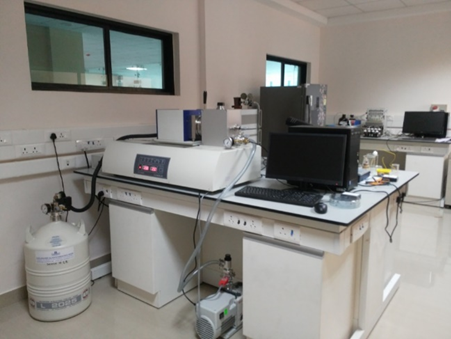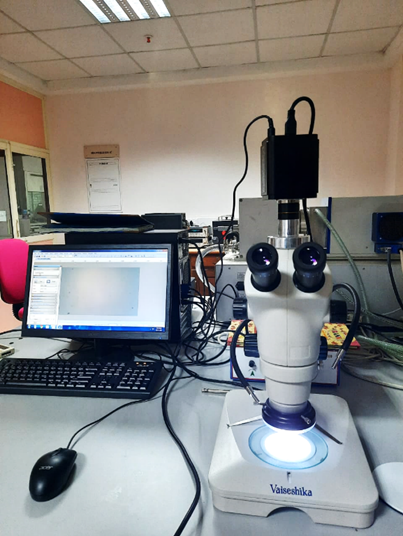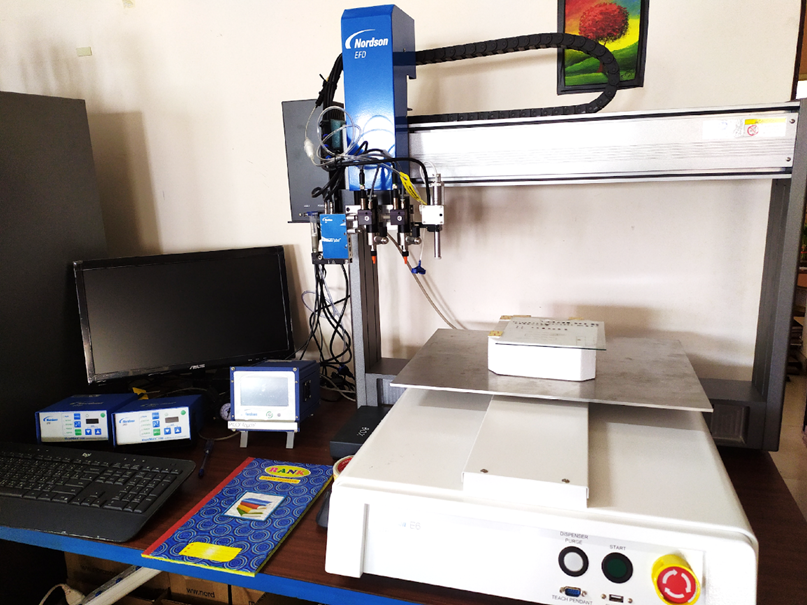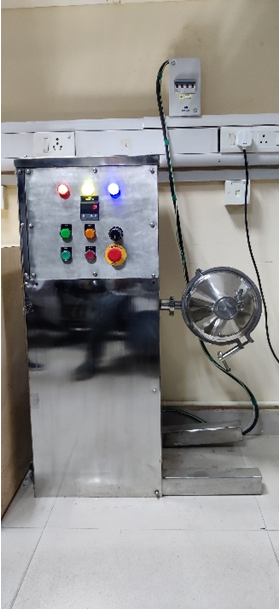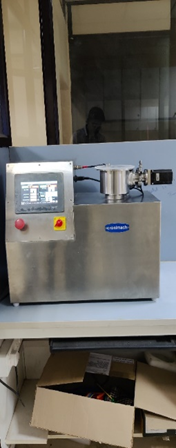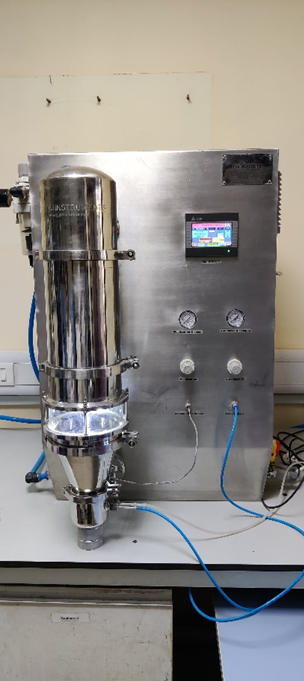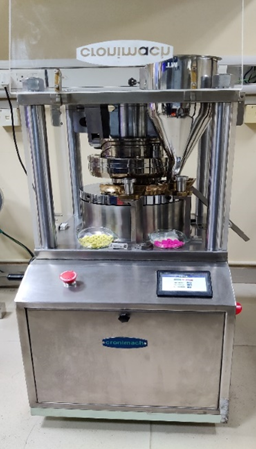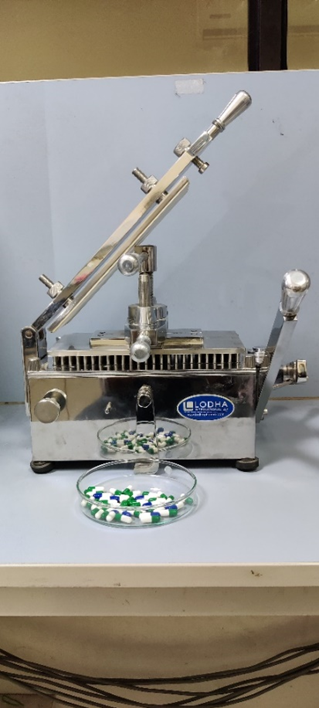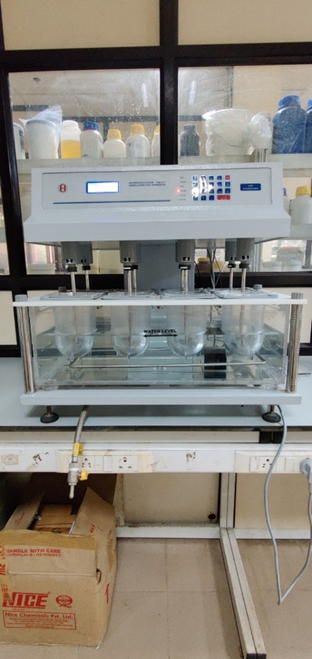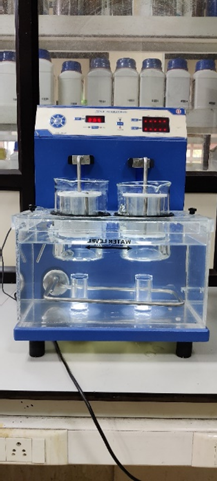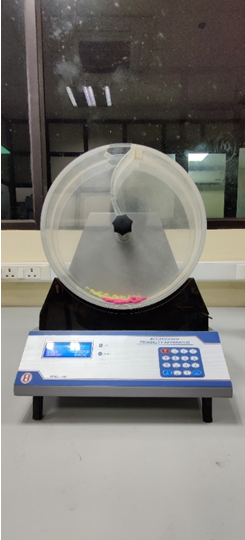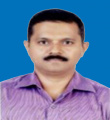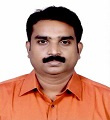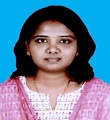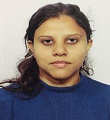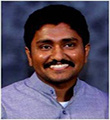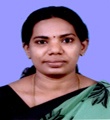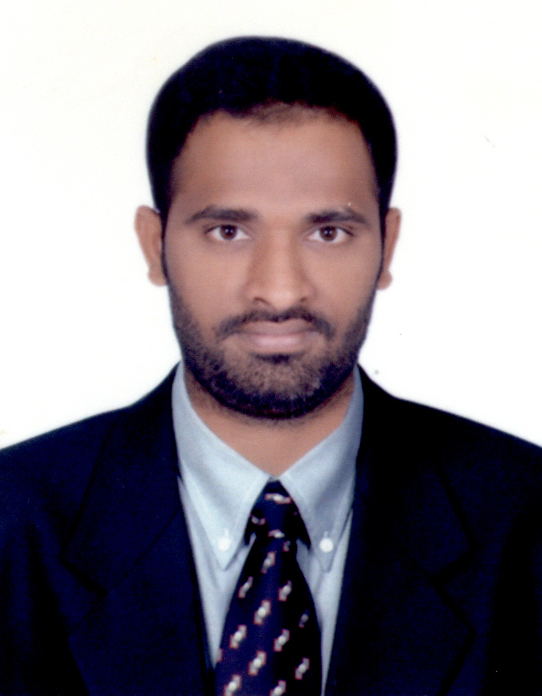Technologies/Know-how
1. Lab-scale process know-how towards Molnulpiravir (EIDD 2801) was transferred to Suven Pharmaceuticals Ltd. in August 2021. [Patent Application No. 202111019499]
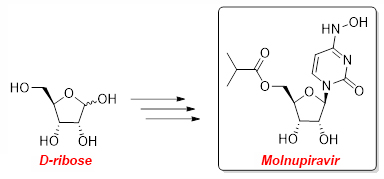
As a part of CSIR’s strategic group initiative to develop new therapies including the repurpose of drugs and new drugs, for COVID-19, the team at CSIR-NIIST worked on developing viable and cost-effective synthetic strategies for the drug; EIDD 2801 (Emory University-Merck).
This drug was approved for use in UK and USA and recently in India for emergency use for COVID-19 treatment. The reported synthetic routes toward this drug started from advanced intermediates, required lengthy steps and proprietary enzymes.
The team at NIIST developed a process starting from the basic starting material D-ribose by reducing the number of process steps and by increasing the overall yield and thereby reducing the cost of production. The developed lab-scale process was jointly transferred by CSIR-NIIST and CSIR-IICT to Suven Pharmaceuticals Ltd. in August 2021.
2. Disinfection-Solidification System for Pathogenic Biomedical Waste Disposal.
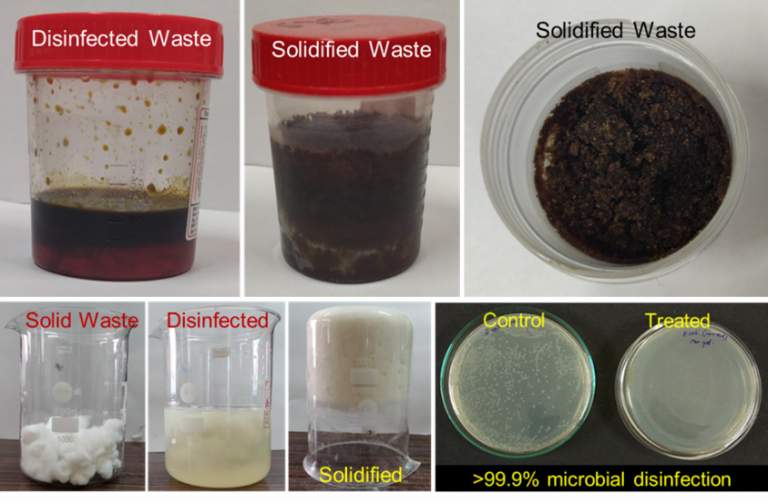
With the advent of Covid-19 and the emergence of harmful microbes including virus, bacteria, fungus, etc., healthcare agencies across the globe have stressed the significance of effectively managing and disposing biomedical waste as the first step towards preventing these infections from uncontrolled spreading. Mismanagement of infectious wastes such as biomedical test samples can cause the transmission of contagious and infectious diseases to a susceptible host upon contamination or occupational exposure.
In this regard, adding a solidifying agent to liquid biomedical waste reduces the risk of spills and aerosolization. If the solidifying agent contains a disinfectant, it may be possible to dispose the waste as non-regulated medical waste, which is less expensive than red-bagging. Solid wastes such as cotton, sharps as well as tissues may also lead to spread of infections and simple absorbers or hypochlorites are not always capable of treating such solid wastes. Acrylate based gelators and super absorbent polymers are used in the treatment of fluidic medical waste. Such materials are, however, not easily recycled and are non-biodegradable.
In an attempt to prioritize the R&D activities towards the national demand in mitigating the spread of the pandemic, the team at CSIR-NIIST developed potential candidates for spontaneous disinfection and immobilization of pathogenic biomedical waste using a dual disinfection-solidification system. The R&D team includes Dr. A. Ajayaghosh (Director), Dr. Sreejith Shankar, Dr. U. S. Hareesh, Dr. P. Sujatha Devi, Dr. S. Savithri and Dr. Rajeev K. Sukumaran.
This system, with inherent antimicrobial activity, is capable of disinfecting both liquid as well as solid samples, and results in gelation, flocculation or complete solidification of the waste instantaneously upon mixing. >99.9% microbial disinfection was observed within 1 minute of contact and the treated waste may be disposed as non-regulated medical waste subject to regulatory approval. Segregation, transportation and disposal of such disinfected medical waste are easier and safer with significant reduction in cost for a healthcare facility.
The team has tested and validated several fluid and solid biomedical waste models including aqueous waste with high salt and sugar concentrations, proteins, highly oxidizing and toxic metal salts, hospital chemicals such as iodine solution, models of urine, saliva and blood, bacterial broths, cotton, tissues, swabs, needles, syringes, and mixtures in the laboratory. Accordingly, three families of patents have been filed to ensure IP protection.
The know-how has been transferred to a start-up in Kerala, Bio Vastum Solutions (BVS) Pvt. Ltd. (Angamaly) and was recently demonstrated in full-scale at the industrial facility. CSIR-NIIST along with BVS, aim at an innovative solution for the safe and environment-friendly management of pathogenic biomedical waste. The team is currently working towards a completely biodegradable solidification system that would provide an innovative and sustainable solution to the pathogenic biowaste disposal issues in the country. This technology is fully aligned to the government missions on Atma Nirbhar Bharat, Swachh & Swasthya Bharat and Start-up initiatives.
3. Technology and process-know how for the fabrication of semi-automatic fabrication equipment’s for dye solar modules.
- India was importing expensive machinery for Dye-sensitized Module (DSM) fabrication
- We achieved ‘Indigenization’ by developing semi-automatic fabrication equipment’s with 60-70% cost reduction
- Capable of making cells, master-plates and modules in 5×5, 10×10, 15×15 and 30×30 cm sizes
- Offers the possibility of custom modifications at any stage
- Technology was licensed for commercialization to Elixir Technologies, Bangalore
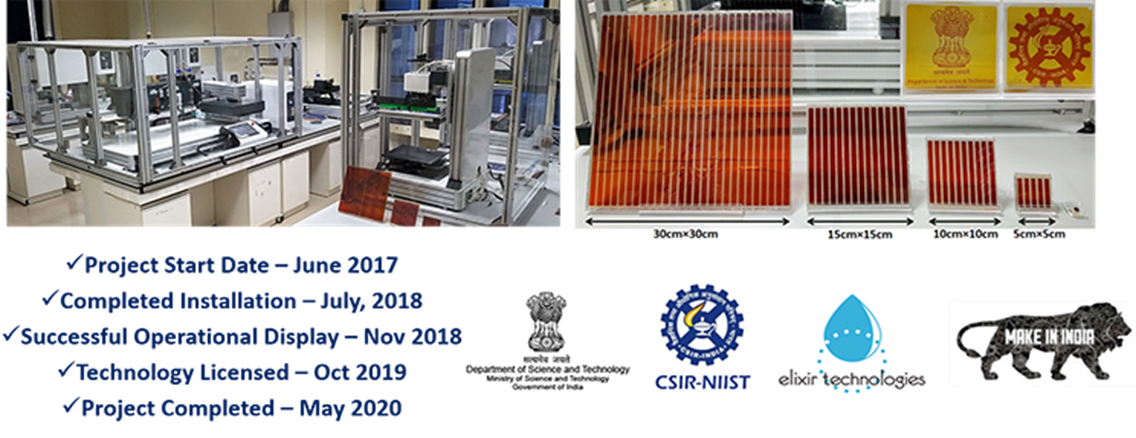

4. Process/product know-how for the making of invisible fluorescent dyes and pigments; Licensee: HueBright Colors Pvt. Ltd., Bangalore
Counterfeiting of currencies, documents, pharma products, and consumer goods is a global problem resulting in substantial economic losses to the nation and companies associated with it. Incorporating fluorescent markers, either through random distribution (fibers) or by printing (ink formulations), is among the most critical anti-counterfeiting measures used worldwide. These materials are currently imported at inflated costs from various countries, which is a threat to national security and results in forex depletion. In this context, the indigenous development of these materials and technologies that are difficult to duplicate is absolutely indispensable. CSIR-NIIST addressed this challenge by developing fluorescent molecules and pigments with appropriate fluorescence characteristics suitable for security printing. These products would help the existing players (public and private) reduce the expenses in terms of import cost and enable their competence in fluorescence-based security solutions.
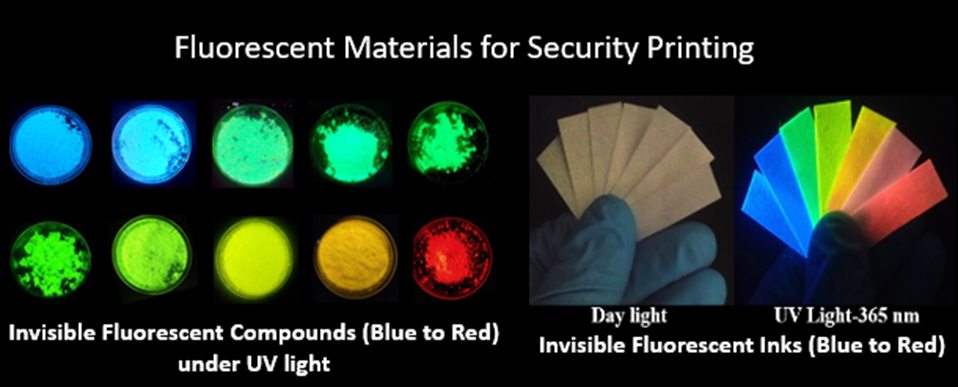
Highlights
Fluorescent Materials for Security Printing
Photosciences and Photonics Section of the Chemical Sciences and Technology Division has proven expertise in the area of fluorescent molecules and materials. The current program is an effort to channelize this multidisciplinary expertise into developing useful products for anti-counterfeiting and security printing applications.

Unique Features:
-
‘Invisible’ and visible fluorescent materials
-
Cost-effective compared to imports
-
The choice of fluorescence shade is virtually limitless
-
Multi-stimuli (light, heat, stress, etc.) responsive luminescence
-
Two contrasting fluorescence under standard and special UV
-
Enhanced security with uncompromised aesthetics
-
Offer both covert and overt methods of protection
Halide Perovskite Based Nanocrystals
Luminescent perovskite nanocrystals (PNCs) are receiving great scientific attention due to their narrow emission with exceptionally high photoluminescence quantum yields and facile tunability of optical band gap over the entire visible region. In addition to photoluminescence, they exhibit fascinating properties such as defect tolerance, tunable morphologies, multiple exciton generation, charge generation and amplified stimulated emission, etc. We focus on the synthesis, photophysical, and optoelectronic properties and applications of PNCs.
Unique Features:
-
Control over size, shape, and aspect ratio
-
Facile tuning of optical properties
-
High stability at ambient conditions
-
Suitable for neuromorphic memory devices
-
LED, Photodetector and Photocatalytic applications
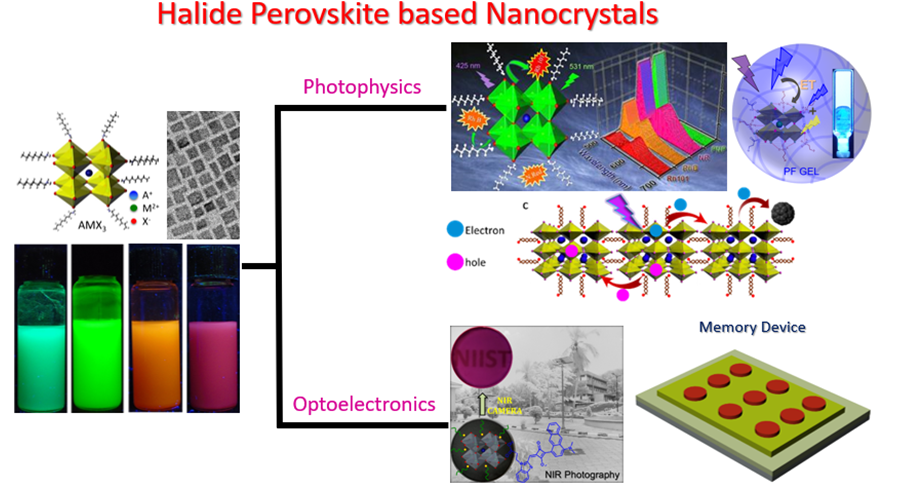
Organic and Hybrid Electronics
Organic Electronics is the branch of technology that deals with electronic devices fabricated using organic materials. The promise of low cost, processing at low temperature and flexible features make them attractive candidates for printable and wearable electronic devices. We focus on developing new device designs for white organic light emitting diodes (OLEDs), organic field-effect transistors (OFETs) for gas sensors and nonvolatile memory and organic photodetectors (OPDs). Organic-inorganic hybrids are given particular attention due to their attractive properties.
Unique Features:
-
White OLED designs with low process complexity
-
Exciplex and electromer based OLEDs
-
OFET based ammonia sensors and VOC sensors
-
Organic/ZnO based UV detectors
Dye Cells for Indoor Photovoltaics & Energy Management
Dye Cells (DSCs) belong to the 3rd generation photovoltaics. Unlike conventional solar cells which require direct sunlight, DSCs function in low/artificial/indirect light, making them ideal for indoor use. They are aesthetically pleasing as the color can be varied by the choice of the dyes used. We have established an indigenous semi-automatic fabrication unit for manufacturing dye sensitized solar modules. We also work on Dynamic Power Windows (DPWs) that combine the benefits of switchable transparency simultaneous with energy generation.

Unique Features:
-
Design and engineering of equipment for 3rd generation photovoltaic sector
-
Provide turn-key solutions for optimized process know-hows and materials
-
Efficiencies >30% with custom engineered indoor photovoltaic dye cells
-
Designed dyes with better absorption matching with artificial light
-
Engineered semiconductor electrodes for BIPV applications
Thermoelectric Materials and Devices
Polymer nanocomposite based thermoelectric materials are a new class of functional materials with immense potential for commercial usage. Devices based on these materials typically operate at < 350 °C and could be used for on-the-spot sustainable power generation. Since more 66% of the produced energy ends up as waste heat, a cost-effective technology that deals with the direct conversion of waste heat into electricity is crucial for realizing green energy generation and utilization challenges.
Unique Features:
-
New p-type organic-inorganic composites
-
New n-type organic-inorganic composites
-
Enhanced stability
-
Module fabrication
-
Thermoelectric (power) generator (TEG)
-
Thermoelectric cooler (TEC)
-
Module performance analysis and optimization
-
Prototype testing and demonstration
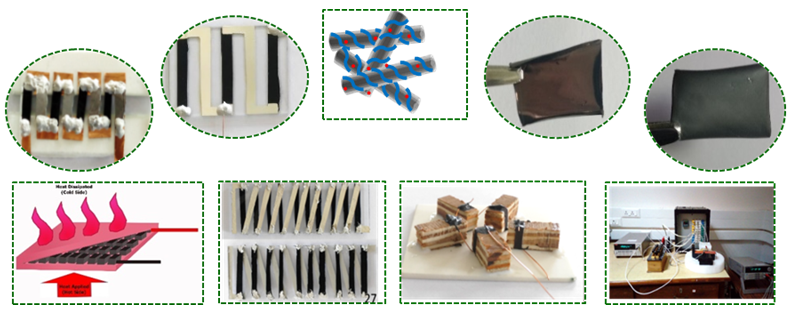
Chromogenic Materials and Devices
Chromogenic materials are a family of ‘smart materials’ that can change their optical properties under the application of an external stimulus. The Photosciences and Photonics Section works on electrochromic, thermochromic and photochromic materials, devices and smart windows. Smart glass technology is envisaged to be one of the best possible strategies towards the management of domestic energy supply, via the regulation of indoor temperature and light and further provides privacy on-demand.

Unique Features:
-
Engineering of New Chromogenic Materials (Organic, Inorganic, Hybrid)
-
Development of Functional Electrolytes (Polymer, Gel, Solid)
-
Indigenous Process and State of the Art Fabrication for Commercialization
-
Multicolor Devices/Prototypes (Leak proof, Cost effective, Color purity)
-
Temperature and Energy Management (?3oC reduction of indoor temp.)
Light Management Technologies for Agrivoltaics
The concept of Agrivoltaics (AV) is now getting global appreciation given the fact that it can increase land-use efficiency, as it highlights the concept of dual-use for the same land area, i.e., for both agriculture activities and PV installation. Hence, by adopting AV on their farm, the farmers are benefitted from dual income by generating both food and energy, thereby meeting the Government of India (GoI) mission for Doubling Farmers' Income. Realising the importance of optics interventions required for solar light energy management in the Agrivoltaics sector, CSIR-NIIST has developed innovative even light-sharing (ELS) AV technology. The developed technology is currently at TRL 4 and can provide AV solutions even to shade-intolerant plants, a major subset of commercial crops. Further, the tunable ray spreading and spectral conversion makes our AV system compatible for variable crop height, Day Light Integral (DLI) requirements, and increased electricity generation by increasing the PV coverage area when compared with state-of-the-art agrivoltaics systems.
Unique Features:
-
Dual income for farmers (Electricity + Crop yield)
-
PAR intensification enhance crop productivity
-
Can turn existing PV plants into Agrivoltaics plants
-
Scope for global standardisation of AV sector uisng ELS-AV technology

Dynamic Power Window Technology
Dynamic windows are widely used in buildings/vehicles to obtain switchable transparency modes, which enables advanced privacy settings as well as it improves the energy efficiency of the built environment. The incorporation of energy generation capability in dynamic windows is a highly welcomed technological advancement, hence listed by U.S. Department of Energy (DOE) as a high priority early-stage R&D topic. As per Building Technology Office (BTO), DOE report (Windows and Building Envelope Research and Development: Roadmap for Emerging Technologies, Feb-2014), the energy generation capability for dynamic windows has excellent potential for high impact and substantial energy savings when it is commercialized. However, BTO predicts longer investment timelines and a higher technical risk to realize energy generation using the available dynamic window technologies. This prediction is based on the unavailability of a suitable stable material having switchable transparency along with energy generation capability, which remains as an R&D barrier. To overcome this R&D barrier, CSIR-NIIST has developed and demonstrated Dynamic Power Window (DPW) technology (TRL 4); a game-changer technology innovation that enables switchable transparency modes along with energy generation capability in all transparency modes, a first of its kind technology. The DPW technology achieves the said capabilities by changing the refractive index of the window layers, simultaneously enabling lateral redirection of the diffuse and direct sunlight, where a PV cell is optically coupled for energy generation. Hence, the developed DPW possess greater advantages of cost reduction and prospectus of energy generation when compared to any other dynamic window glasses, making it attractive to a mass audience.
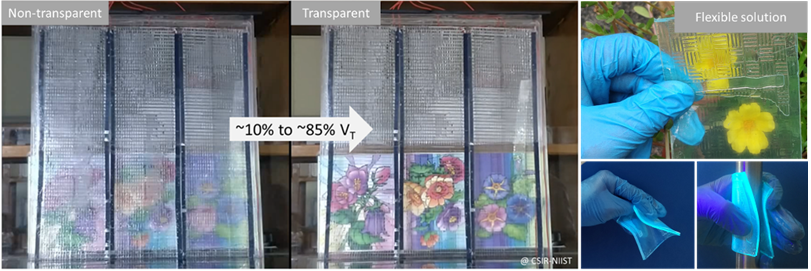
Unique Features:
-
Integrate both energy efficiency and clean energy generation in a single platform
-
Active control on transparency modes
-
Energy generation in all transparency modes
-
Tunable geometrical light concentration
Handheld Raman Spectrometer
Raman spectroscopy is a powerful tool for material identification, chemical analysis and sensing applications. The unique advantages of portability, native non-destructive and rapid analysis qualify them best devices for onsite analysis including authentication and detection of adulteration.
We have the expertise in fabrication of highly customized handheld Raman spectrometer, tailored for specific applications and equipping it with the software for automated analysis such that the instrument can be carried anywhere and is operable by anyone. We also have the know-how for producing of SERS substrates (nanostructured plasmonic materials), which can be used for trace level detection.
Unique Features:
-
Portable, battery operable and cost effective devices
-
Fast and non-destructive analysis
-
No requirement for sample preparation
-
No trained personal for analysis
-
Onsite material identification, authentication and biological analysis
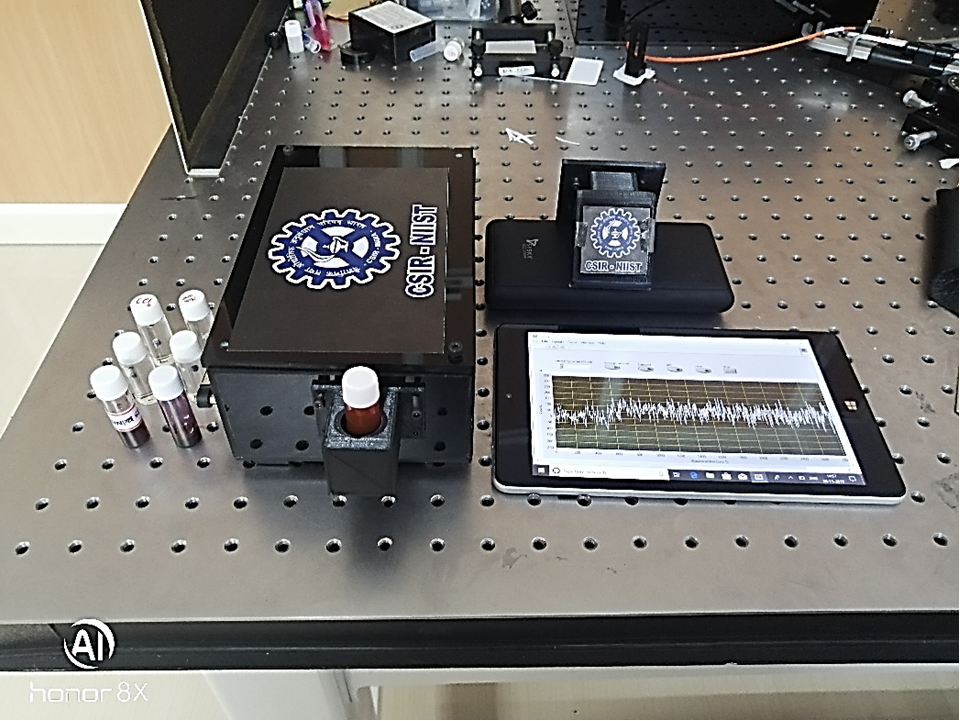
Ultrafast Spectroscopy – Excited State Properties
The chemical bonds break, form, or geometrically change with surprising rapidity during the transformation of reactants to products. This ultrafast transformation is a dynamic process involving the mechanical motion of electrons and atomic nuclei. As the speed of atomic motion is ~1 km/second, the average time required to experiment atomic-scale dynamics over a distance of an angstrom is ~100 femtoseconds. Hence the advantage of using ultrashort pulses is that they open the door to investigate the dynamics of the system directly, i.e., the movement of individual particles such as electrons or atoms.
We investigate the ultrafast excited state relaxation dynamics involved in the photofunctional materials and protein-lipids interaction dynamics upon ultrafast laser excitation.
Unique Features:
-
Dynamics of Intramolecular Singlet Fission Process
-
Solvation and (Twisted) Intramolecular Charge Transfer Dynamics
-
Dynamics of Thermally Activated Delayed Fluorescence
-
Excited State Symmetry Breaking
Natural Product Chemistry
Harnessing the natural wealth (plant/herbal/microbial) of the region to obtain novel biologically active compounds or leads for drug synthesis, exploring traditional systems of medicine including Ayurveda, Siddha and tribal medicine for lead structures and correlating/corroborating this wealth of knowledge with modern diagnostic chemical and biological testing methods. The natural products isolated from plants/microbial cultures are screened against several biological targets for antibacterial, antiviral, anti-inflammatory activities. This is done through interdisciplinary collaborations within the institute and also with several national laboratories and universities. In addition, we have a very good facility for in vivo screening of molecules with biological potential. The abundant natural products are synthetically modified for enhancement of biological activity. By utilizing the rich repository of phytomolecules, we are supporting the quality control/standardization of herbal raw materials and finished products for Ayurveda and herbal industry. The scientific validation of herbal formulations, both classical and proprietary products are taken up in the institute. We have established a facility for herbal formulations with special focus on making galenical formulations of traditional medicines.
Unique Features:
-
Methodological explorations for effective evaluation and validation of traditional wisdom
-
Exploration of the medicinal plants and microbes of the Western Ghats
-
Large repository of phytomolecules and analogues
-
Advanced hits against MDR strains of Staphylococcus aureus
-
Skill and expertise for isolation and characterization of natural products.
-
Semisynthetic modification of natural products
-
Multi-disciplinary and multi-institutional projects in CNS disorders and infectious diseases
Development of sustainable and green methods for chemical synthesis
The quest for sustainable development in chemistry has tempted both organic chemists and environmental chemists to search for green and environmentally friendly methodologies. For sustainable development, the methodologies should address three main factors: 1) reduced consumption of raw materials and energy, 2) maximum use of renewable resources and 3) minimal use of harmful chemicals. These new methods must be environment friendly with minimum of waste, with high efficiency and by utilizing processes with 100 % atom economy. There is an increasing demands for product safety and efficacy in the chemical industry and allied branches and this trend is evident in other branches of industry as well, due to increasing concerns for biodegradability of the products. The development of efficient methods to access complex molecules with multiple stereogenic centers has become a substantial challenge in both academicresearch and industrial applications. The growing importance of the chemical industry and other branches as part of Make in India initiatives of Government of India and the growing needs of effective, environmentally sound production methods, we are focusing developing sustainable methods by developing novel and efficient green routes for chemical synthesis.
Unique Features:
-
Sustainable synthetic routes towards scaffolds for medicinal and material interests
-
Green chemistry routes for chemical intermediates, agrochemicals and advanced pharmaceutical ingredients
-
Organic photochemistry methodologies for green synthesis
Diagnostics and Nanotheranostics for Biomedical Applications
Chronological development of common methods used in molecular biology, biochemistry, cytopathology, and genetics are based on various manipulation of analysis of proteins, nucleic acids and lipids. These techniques are broadly covered in diagnostic pathology viz., neoplastic disorders, infectious diseases, inherited conditions and identity determination. Modern techniques such as surface enhanced Raman spectroscopy (SERS) has evolved as a potential ultrasensitive diagnostic tool for wide range of disease detection. In biomedical applications, we explore nanoparticles (NPs) for drug delivery and imaging. Carefully fabricated NPs with cell targeting ligands are loaded with suitable cargo to assemble ‘nanotheranostics’ which enable to monitor therapy in a real-time manner so as to improve the safety and drug efficacy for personalized medicine.
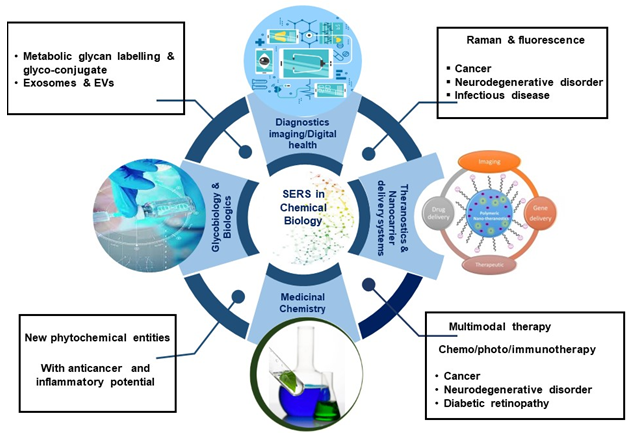
Unique Features:
- Diagnostic Nanoparticle probes: SERS-tags for label-free / SERS-labelled / SERS –kit
Ultrasensitive detection and imaging of human cancer / cancer biomarkers
Detection of infectious diseases
Early detection and monitoring of neurodegenerative disorders
- Multimodal theranosticnano-probes based on SERS & fluorescence
Multimodal cancer therapy by targeted nano-carrier delivery system: chemo-photo; chemo-immunotherapy
Combined therapy on diabetic retinopathy using nano-delivery system
Medicinal Chemistry and Chemical Biology
Medicinal plants have demonstrated their potential as a repository of bio-active molecules with promising therapeutic potential and represent an important pool for the identification of novel drug leads. In an attempt to investigate new phytochemical entities (NPCEs), naturally occurring phytomolecules are subjected to semi-synthetic modification which transform to pharmacologically active NPCEs as a lead candidate for clinical translation. In-depth investigations underlying molecular mechanisms were ruled out using detailed in vitro and in silico approach. In the area of chemical biology, an interdisciplinary team is investigating the intrinsic complexities of cell-surface glycans that impede to track the metabolic changes in cells. Metabolic glycan labelling (MGL) on the cell surfaces plays a pivotal role in cellular recognition like cell–cell communication and host–pathogen interactions etc. Moreover, fundamental structural changes have been observed in the course of many physiological processes which leads to the development of disease (e.g., cancer) progression.
Unique Features:
-
Semi-synthetic modification of bioactive natural products isolated from plants
-
New Phytochemical Entities (NPCEs) as advanced Hits / Leads towards anti-cancer, anti-inflammatory, anti-diabetic potential
-
New Glycan labelling sugar analogues for Metabolic Glycan labelling (MGL)
-
Investigate new metabolic pathway and corelate with the disease progression by metabolic oligosaccharide engineering (MOE) strategy
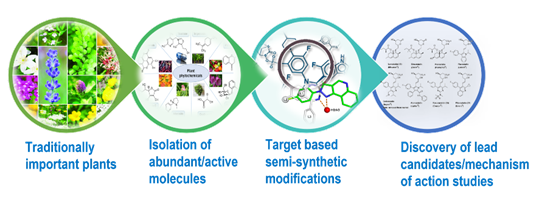
Process Development Towards Chemical Entities
The team working on process development has successfully established different technologies for synthesizing active pharmaceutical ingredients (Nitazoxanide, Galidesivir, Molnupiravir and EIDD 1931), fluorescent dyes (red, blue, green and yellow) for security applications and agrochemicals (Flonicamid and spirotetramat). We focus on developing processes that utilize indigenous raw materials that are readily available. Another important factor that we take care of is the reduction in number of process steps and also avoiding purification by column chromatography thereby decreasing the cost of production.
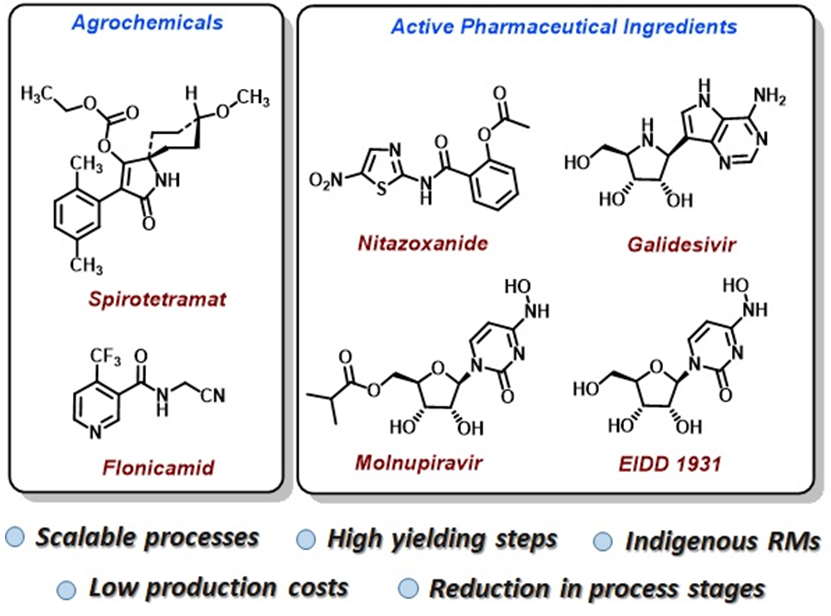
Unique Features:
-
Scalable processes utilizing easily available raw materials
-
Reduction in process steps and production cost
-
High yielding steps that doesn’t require expensive purifications
Structural Chemistry and Crystal Engineering
Our research focuses on crystal engineering methods to develop solid forms (polymorphs, cocrystals, salts, solid solutions, and eutectics) of active pharmaceutical ingredients (APIs) with superior physicochemical properties and optimal mechanical properties to attain better tabletability. On the material research front, we work on developing flexible crystalline materials with unique nanomechanical response and emission characteristics.
Unique Features:
-
Solid forms of BCS class II drugs with superior physicochemical properties
-
Polymorphic forms and comprehensive studies of their phase transformation.
-
Nanomechanical studies to understand the structure-mechanical correlations.
-
Flexible molecular crystals with unique emission characteristics.
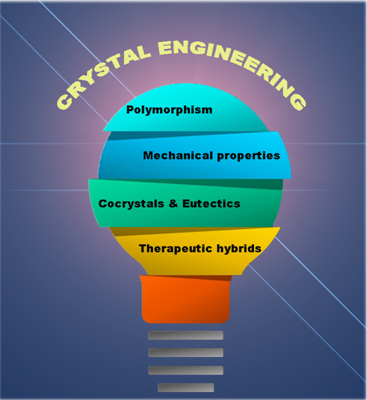
Allopathic and Herbal Drug Formulations
Pharmaceutical formulation development connects the discovery of a new drug substance to the successful development of final commercial drug product. Formulation is the process in which active pharmaceutical ingredients (APIs) are combined in precious propositions with excipients to create a specific product to achieve the desired characteristics in the final products e.g. Taste, color, shelf-life, performance or effectiveness and patient compliances. We focus on developing various galenical formulations of both allopathic and herbal drugs.
Unique Features:
-
Development of knowledge base for pharmaceuticals formulations
-
All oral dosage forms (Tablets, Capsules, Syrups, Suspensions and Emulsions)
-
Topical semisolid dosage forms (Gels, Ointments and Creams)
-
Development of Generic drugs/Novel APIs/Poly-herbal drugs/Phytopharmaceuticals
-
Modernization of Ayurvedic formulations to produce patent & proprietary medicines
-
Novel Drug Delivery Systems (NDDS)
Research Facilities
Major Equipments
Fabrication Facility
Formulation Facility
Other Equipments
-
Atomic force microscopy (NTEGRA NT0MDT)
-
Femtosecond pump probe spectrometer (CDP-2022i)
-
Nanosecond laser flash photolysis system (INDI-40-10-HG)
-
Picosecond time correlated single photon counting system (Delta Flex Detector PPD850)
-
Handheld Raman spectrometer (Mira DS Advanced)
-
yray Analyzer, ECIL.
-
UV-vis spectrophotometer (Shimadzu UV-2600)
-
UV-vis-NIR spectrophotometer (Perkin Elmer Lambda-950)
-
UV-vis-NIR Modular spectrometer (Ocean Optics DH-200-BAL)
-
Flame-Chem UV-vis spectrometer (Ocean Optics FLMS06876)
-
Spectrofluorimeter (Fluorolog 3 FL3-221)
-
Fluorescence spectrophotometer (HORIBA)
-
Modular spectrometer (NIR Quest 512-2.5 Ocean optics)
-
Circular dichroism spectropolarimeter (JASCO J810)
-
Optical microscope (Olympus 2000)
-
Optical polarizing and fluorescence microscope (Leica DM 2500P)
-
Dark field microscope (CYTOVIVA)
-
DNA/RNA synthesizer (H-6/H-8 VERO211 DNA Synth)
-
Dynamic light scattering (MALVERN Zetanano ZS-S)
-
HPLC recycling (LC-9260)
-
HPLC recycling preparative (LC9225 NEXT)
-
HPLC recycling preparative (LC 9101, JAI)
-
HPTLC (DESGAGA)
-
HPLC analytical (L.2000 HITACHI)
-
CHNS analyser (Elementar Analyser Vario Micro cube)
-
Parametric Analyser (4200A-SCS)
-
High energy mixer-mill (Labindia MM1100)
Scientist

Dr.Radhakrishnan K V
Chief Scientist & Head, CSTD- 0471-2515420
- radhu[at]niist[dot]res[dot]in

Dr.Narayanan Unni K N
Senior Principal Scientist & Head, Photosciences- 0471-2515364
- unni[at]niist[dot]res[dot]in
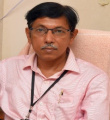
Dr.Kaustabh Kumar Maiti
Senior Principal Scientist- 0471-2515475
- kkmaiti[at]niist[dot]res[dot]in

Dr.Biswapriya Deb
Senior Principal Scientist- 0471-2515478
- biswapriya[dot]deb[at]niist[dot]res[dot]in

Dr.Karunakaran Venugopal
Principal Scientist- 0471-2515240
- k[dot]venugopal[at]niist[dot]res[dot]in

Dr.Ravi Shankar L.
Principal Scientist- 0471-2515317
- ravishankar[at]niist[dot]res[dot]in, raviweblog[at]gmail[dot]com

Dr.Vijayakumar Chakkooth
Principal Scientist- 0471-2515484
- cvijayakumar[at]niist[dot]res[dot]in

Dr.Sunil Varughese
Principal Scientist- 0471-2515438
- s[dot]varughese[at]niist[dot]res[dot]in

Dr.Sreejith Shankar P
Senior Scientist- 0471-2515333
- sreejith[dot]shankar[at]niist[dot]res[dot]in

Sri.Robert Philip
Senior Technical Officer (2)- 0471-2515235
- robert[at]niist[dot]res[dot]in
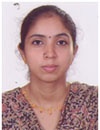
Smt.Saumini Mathew
Senior Technical Officer (2)- 0471-2515281
- sauminimathew[at]niist[dot]res[dot]in



